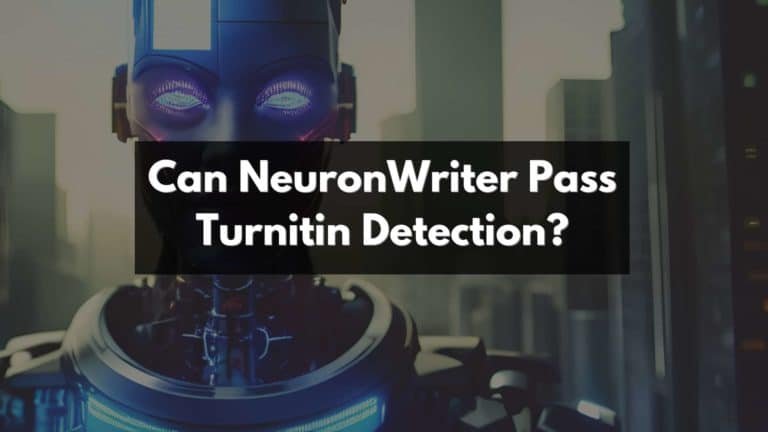Can WordAI Pass Turnitin Detection?
Are you wondering if WordAI can slip past Turnitin’s keen AI detection? You’re not alone. As AI writing tools like WordAI gain popularity, more individuals are curious about their ability to evade plagiarism checks such as those offered by Turnitin.
This article aims to enlighten you on the capabilities and limitations of WordAI in bypassing Turnitin’s advanced AI Detection system. Let’s dive into this intriguing technological face-off!
Key Takeaways
- WordAI claims to be able to help AI – generated content pass Turnitin’s AI detection and plagiarism checks, but there are limitations and challenges involved in bypassing Turnitin’s advanced technology.
- Turnitin’s AI detection tool is highly accurate in identifying copy produced by platforms like ChatGPT, making it difficult for WordAI or similar tools to go undetected.
- To avoid plagiarism and ensure content originality, writers should prioritize academic integrity by conducting effective research, using proper paraphrasing techniques, understanding assignment briefs thoroughly, and citing credible sources.
- While WordAI may offer a risk-free trial to test its abilities, relying solely on automated tools like this may not provide a long-term reliable solution. It is important to develop strong research skills and utilize proper paraphrasing techniques when creating content.
Understanding Turnitin AI Detection
Turnitin AI Detection operates by utilizing parameters and flags to identify AI-generated content, and its model is continually trained to improve accuracy.
How Turnitin AI Detection works
Turnitin AI Detection operates using sophisticated artificial intelligence technologies. Driven by machine learning algorithms, it analyzes written content for originality, checking for potential instances of unoriginal or plagiarized work.
It scrutinizes each document sentence-by-sentence, comparing them to billions of web pages, books, and academic articles in its database. Unlike traditional plagiarism software that primarily focuses on word-for-word text matches, Turnitin’s AI leverages contextual analysis to detect paraphrased content as well.
Moreover, with the advent of AI-generated content from tools like WordAI and ChatGPT, Turnitin further improved its model training to accurately identify such material thereby bolstering academic integrity – a fact vividly discussed across various platforms including Reddit.
Parameters and flags used for detecting AI writing
Turnitin’s AI detection technology utilizes various parameters and flags to identify AI-generated writing. These include:
- Text Analysis: Turnitin’s algorithm analyzes the text for patterns, inconsistencies, and unusual phrase constructions that are commonly associated with AI-generated content.
- Content Authenticity: The system compares the writing style, vocabulary usage, and structure of the submitted content with existing databases to determine its authenticity.
- AI Writing Detection: Turnitin’s model is trained to recognize specific markers and language patterns that are indicative of AI-generated writing, such as excessive word repetition or unnatural sentence formations.
- Training of Turnitin’s Model: The technology is continuously updated and trained on a wide range of text samples, including those generated by popular AI content tools like GPT models, to improve its accuracy in detecting such content.
- Text Similarity Comparison: Turnitin compares the submitted text against a vast database of academic papers, online sources, and previously submitted documents to identify similarities or overlaps in the content.
- Unoriginal Content Detection: The system checks for any instances of plagiarism by identifying content that matches or closely resembles existing sources.
Training of Turnitin’s model
Turnitin’s model is trained using a combination of machine learning techniques and human expertise. It analyzes vast amounts of text data to create a reference database that aids in identifying similarities between submitted content and existing sources.
The training process involves feeding the system with various writing samples, both original and plagiarized, to enhance its ability to detect AI-generated content accurately. Turnitin’s commitment to continuous improvement ensures that its model evolves alongside advancements in AI writing technology, enabling it to effectively flag potential instances of plagiarism and maintain academic integrity.
Can WordAI Pass Turnitin Detection?
WordAI’s capabilities in passing Turnitin Detection are impressive, but there are limitations and challenges involved in bypassing Turnitin AI detection.
WordAI’s capabilities in passing Turnitin Detection
WordAI is an AI content writing tool that claims to have the ability to help AI-generated content pass Turnitin’s AI detection and plagiarism checks. While it may offer a risk-free trial for users to test its capabilities, it is important to note that Turnitin’s new AI detection tool has shown impressive accuracy in identifying copy written by platforms like ChatGPT.
Despite WordAI’s claims, bypassing Turnitin’s AI detection can be challenging due to the sophisticated algorithms and parameters used in detecting AI writing. It is always advisable to prioritize academic integrity by following best practices such as understanding assignment briefs, conducting thorough research, utilizing proper paraphrasing techniques, and using credible sources when creating content.
Limitations and challenges in bypassing Turnitin AI detection
Bypassing Turnitin AI detection poses several limitations and challenges. Despite claims from tools like WordAI, there is no foolproof method to guarantee undetectable AI-generated content.
Turnitin’s AI detection technology has proven to be remarkably accurate in identifying copy produced by language models like ChatGPT. Additionally, as Turnitin continuously trains its model on new data, it becomes more adept at recognizing patterns of AI writing.
Moreover, while WordAI may offer a risk-free trial for users to test its ability to pass AI detection, relying solely on this tool might not provide a reliable long-term solution. There is always a possibility that Turnitin will develop new algorithms or update their existing ones to counter any techniques used by WordAI or similar tools.
To maintain academic integrity and avoid the risk of getting flagged for plagiarism:
– Understand assignment briefs thoroughly.
– Conduct comprehensive research using credible sources.
Best Practices to Avoid Plagiarism and AI Detection
To avoid plagiarism and AI detection, it is essential to understand assignment briefs, conduct thorough research, utilize proper paraphrasing and summarizing techniques, and rely on credible sources.
Understanding assignment briefs
To ensure your AI-generated content can bypass AI content detection, it’s crucial to thoroughly understand the assignment brief. This means carefully reviewing and analyzing the instructions provided by your teacher or professor.
Focus on key elements like the topic, word count, formatting requirements, and any specific sources or references that need to be included. By fully comprehending the assignment brief, you’ll be better equipped to create original and authentic content that aligns with the given guidelines.
Remember, meeting these requirements is essential for avoiding plagiarism detection tools like Turnitin.
Conducting effective research
Properly conducting research plays a vital role in producing original and authentic content, especially when trying to bypass AI content detection. By thoroughly researching your topic, you can gather accurate information from credible sources and ensure that your writing is unique.
Turnitin’s AI detection tool is impressively accurate at identifying ChatGPT-written copy, so it’s crucial to avoid relying solely on AI-generated content. Instead, use WordAI as a helpful tool while incorporating your own research and knowledge into the writing process.
This combination of reliable research and thoughtful usage of WordAI can help you create content that is less likely to be flagged by Turnitin’s AI detection capabilities.
Proper paraphrasing and summarizing techniques
To ensure your content passes Turnitin’s AI detection and plagiarism checks, it is crucial to master proper paraphrasing and summarizing techniques. Here are some key strategies to abide by:
- Understand the original text: Read and comprehend the source material thoroughly before attempting to paraphrase or summarize it.
- Change sentence structure: Avoid copying the original sentence structure verbatim. Rearrange the sentence structure, rephrase sentences, and substitute synonyms for key words.
- Use different words: Replace specific terms with alternative words that convey the same meaning. Make sure not to use a thesaurus excessively, as it can lead to awkward or incorrect language usage.
- Maintain original meaning: Capture the essence of the original text while conveying it in your own words. Focus on preserving the author’s main ideas and arguments rather than replicating their exact wording.
- Cite and attribute sources: Always provide proper citations when using information from external sources, even when paraphrasing or summarizing. This demonstrates academic integrity and ensures you are giving credit where it is due.
Using credible sources
To ensure that AI-generated content passes the detection and plagiarism checks, it is crucial to use credible sources. Credible sources refer to those that are reliable, authoritative, and verifiable.
Utilizing reputable scholarly journals, books from established publishers, official websites of organizations or institutions, and government publications can help maintain the authenticity and originality of the content.
By citing information from trusted sources, it becomes less likely for AI content to be flagged as plagiarized or unoriginal by Turnitin’s AI detection tool. So remember to choose your sources wisely when creating AI-generated content for academic purposes.
Conclusion
In conclusion, while WordAI claims to help AI-generated content pass Turnitin’s AI detection and plagiarism checks, there are limitations and challenges in bypassing Turnitin’s advanced technology.
Turnitin’s AI detection tool has proven to be accurate in identifying ChatGPT-written copy, making it difficult for WordAI or any other tool to go undetected. It is important for writers to prioritize academic integrity by conducting effective research, using proper paraphrasing techniques, and citing credible sources to avoid plagiarism and ensure content originality.
FAQs
1. Can WordAI pass Turnitin’s plagiarism detection software?
No, WordAI is an AI-powered content spinning tool that generates unique versions of existing content. While it may help evade some plagiarism detection tools, it is not foolproof and can still be flagged by advanced systems like Turnitin.
2. Is using WordAI considered ethical for academic purposes?
Using WordAI or any other automated content generation tool to create academic papers or assignments is generally considered unethical and a form of cheating. It undermines the integrity of the educational system and can result in severe consequences if caught.
3. Does purchasing a subscription to WordAI guarantee originality in my writing?
No, even with a subscription to WordAI, there is no guarantee that the generated content will be completely original or free from plagiarism. While it may offer variations of existing text, it cannot replace proper research and critical thinking required for creating authentic academic work.
4. How reliable are Turnitin’s plagiarism detection results when checking against spun content from tools like WordAI?
Turnitin employs advanced algorithms and databases to detect similarities between submitted documents and existing sources, including spun content generated by tools like WordAI. Although it may not catch every instance of spun text, Turnitin has evolved to identify patterns commonly used by such tools, making their results quite reliable in flagging potential instances of plagiarism.





